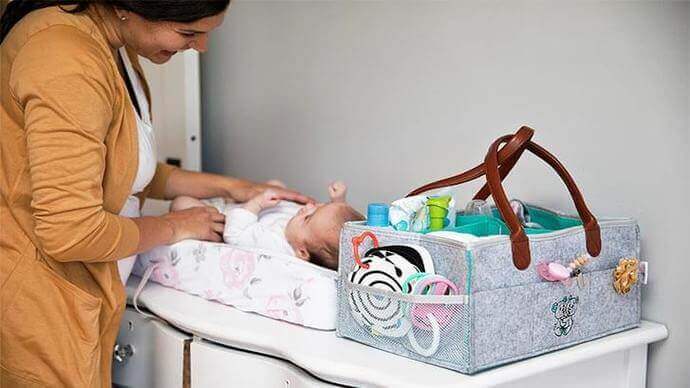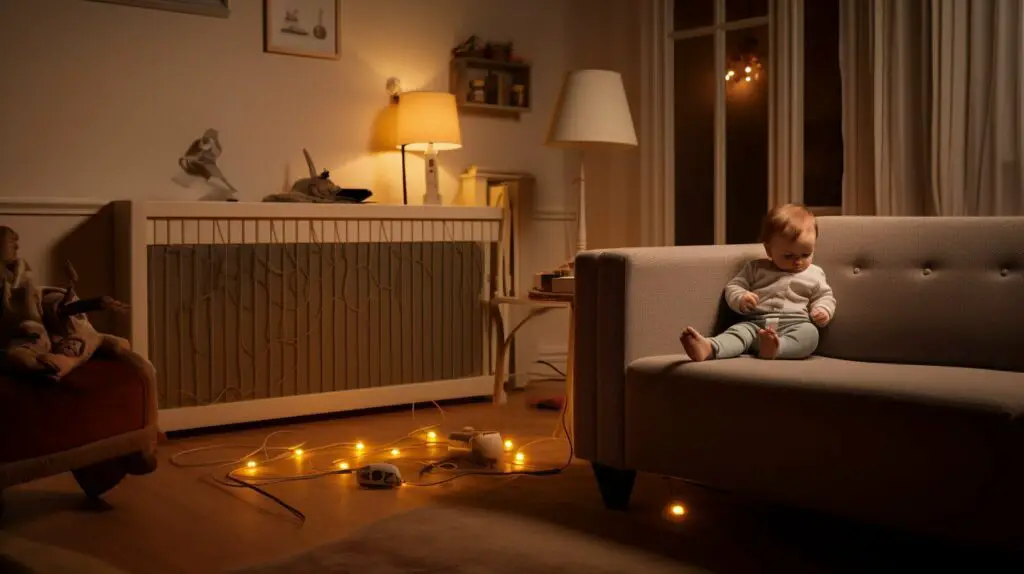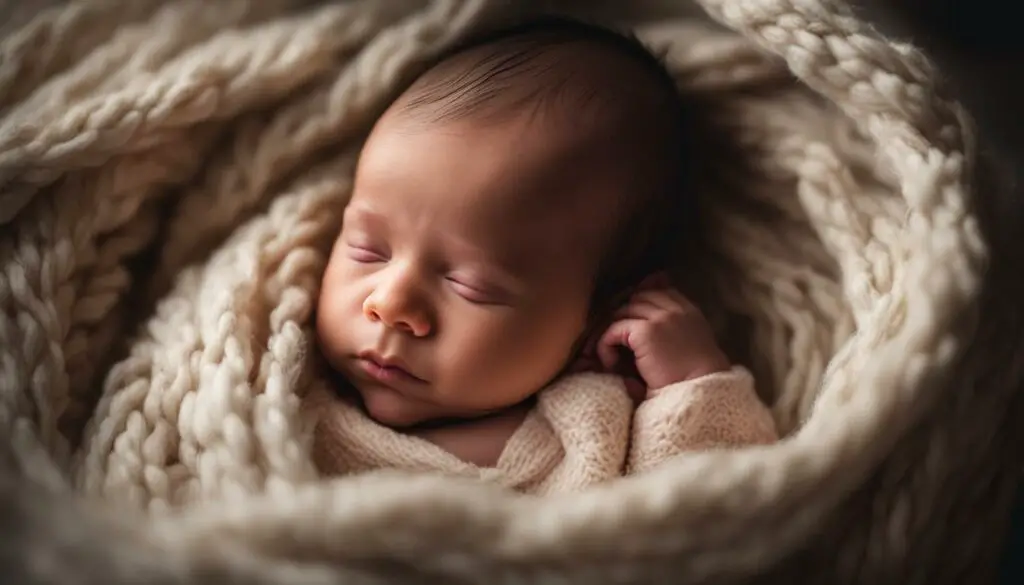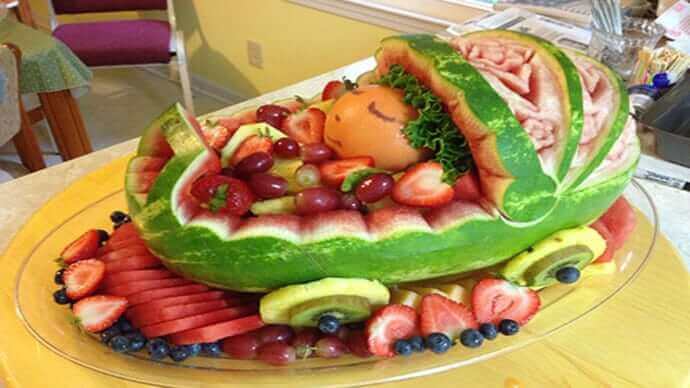Congratulations on your little one’s newfound mobility! As exciting as it is to see your baby start crawling, it’s important to create a safe environment for them to explore. Baby proofing your home can prevent accidents and give you peace of mind.
In this article, you will learn about the most common hazards in a home for a crawling baby and how you can baby proof your home to prevent accidents. We’ll cover safety measures for cords, outlets, stairs, furniture, chemicals, medications, cleaning supplies, sharp objects, and choking hazards.

Key Takeaways
- Baby proofing your home is important to ensure your baby’s safety while they crawl.
- Common hazards in a home for a crawling baby include sharp objects, choking hazards, and small objects.
- Preventing accidents can be done by creating physical barriers and removing potential dangers.
- Safety measures for cords and outlets include cord clips, outlet covers, and cordless blinds.
- Stairs can be made safe by installing baby gates, securing banisters, and keeping stairways clear of clutter.
- Furniture should be secured to prevent tipping, and sharp edges can be covered with corner protectors.
- Chemicals, medications, and cleaning supplies should be locked away and stored out of reach.
- Sharp objects should be stored out of reach, and decorative items that pose a risk should be avoided.
- Choking hazards and small objects can be prevented by regularly inspecting toys, avoiding small parts, and using coin-sized object testers.
- Additional precautions for baby proofing include supervision, teaching boundaries, and regularly updating safety measures.
- Use our comprehensive checklist to ensure you have covered all necessary safety measures.
Common Hazards in a Home for a Crawling Baby
As a parent, it’s important to be aware of the hazards that exist in your home for a crawling baby. At this stage, your little one is exploring the world and everything in it, which means they’re at risk for potential dangers. Here are some of the most common hazards to be aware of:
| Hazard | Description |
|---|---|
| Sharp objects | Knives, scissors, and other sharp objects should always be stored out of reach or kept in locked drawers. |
| Choking hazards | Avoid small toys, hard candy, nuts, grapes, and other foods that can cause choking. Regularly inspect your baby’s toys for small parts. |
| Small objects | Coins, buttons, and other small objects can pose a choking hazard. Use a coin-sized object tester to determine if something is too small for your baby. |
To provide your baby with a safe environment, it’s essential to baby proof your home and take the necessary safety measures.
Remember, it’s always better to be safe than sorry when it comes to your little one’s well-being.
Baby Proofing to Prevent Accidents
When it comes to baby proofing your home for a crawling baby, preventing accidents should be your top priority. Here are some tips to help you create a safe environment:
1. Create physical barriers: Use baby gates to block off stairways, and install safety locks on cabinets and drawers to keep hazardous items out of reach.
2. Remove potential dangers: Clear the floor of clutter, and secure loose cords and wires to prevent tripping hazards. Store small objects and choking hazards out of reach or in locked cabinets.
3. Keep electrical outlets safe: Cover all electrical outlets with outlet covers, and use cord clips to keep cords out of reach. Consider using cordless blinds to eliminate the risk of strangulation.
4. Secure banisters and railings: Use safety gates at the top and bottom of staircases, and secure any loose banisters or railings to prevent falls.
5. Make furniture safe: Secure heavy furniture to the wall, and use corner protectors to prevent injuries from sharp edges. Avoid using furniture with glass surfaces or sharp corners.
6. Store hazardous items properly: Keep all chemicals, medications, and cleaning supplies in locked cabinets or out of reach. Use child-resistant containers and store them in a high location.
7. Keep sharp objects away: Store knives and other sharp objects in a locked drawer or cabinet, and avoid using decorative items with sharp edges.
8. Prevent choking hazards and small objects: Regularly inspect toys for small parts, and use a coin-sized object tester to ensure that objects are too large to be swallowed. Keep small objects out of reach.
By taking these precautions, you can baby proof your home and prevent accidents while providing a safe environment for your little one to explore.
Cords and Outlets Safety Measures
As your little one starts to crawl and explore their surroundings, it’s important to pay attention to the potential hazards that exist in your home. One area that requires particular attention is cords and outlets. Follow these safety measures to ensure your baby’s safety:
- Use cord clips to secure cords to walls and furniture, keeping them out of your baby’s reach.
- Install outlet covers to prevent your baby from accessing electrical outlets.
- Consider using cordless blinds or keeping cords tied up and out of reach.
These safety measures will go a long way in preventing accidents and ensuring your little one can explore their environment safely and securely.
Stairs Safety Measures
Stairs can be a major hazard for a crawling baby. To keep your little one safe, it’s important to take the necessary safety measures. Firstly, install baby gates at the top and bottom of the stairs to prevent your baby from accessing the staircase. Make sure the gates are installed properly and are secure.
Next, ensure that the banisters are secured and that any gaps are too small for your baby to fit through. If necessary, install plexiglass or netting to cover any gaps. Keep the stairways clear of clutter so that your baby cannot trip or fall over objects.
It’s also important to supervise your baby when they are near the stairs. Never leave your baby unattended near a staircase, even if a baby gate is installed. Additionally, teach your little one to crawl down the stairs backwards, as this is the safest way to navigate them.
Stairs Safety Measures Checklist:
- Install baby gates at the top and bottom of the stairs
- Ensure that the banisters are secured and any gaps are covered
- Keep stairways clear of clutter
- Supervise your baby when they are near the stairs
- Teach your baby to crawl down the stairs backwards
Furniture Safety Measures
When it comes to baby proofing your home, securing your furniture is crucial to prevent accidents. Heavy furniture such as bookshelves, dressers, and cabinets can tip over easily, causing serious harm to your little one.
Here are some furniture safety measures you should consider:
- Secure heavy furniture to the wall using anti-tip brackets or straps.
- Use corner protectors on all furniture with sharp edges to prevent injuries.
- Avoid furniture with glass components that could break and injure your baby.
- Remove any small items that can be swallowed or choked on from furniture tops or reachable shelves.
Make sure to regularly inspect your furniture and check for loose bolts or unstable pieces. If you have a baby walker, avoid using it near furniture that could tip over.
Chemicals, Medications, and Cleaning Supplies Safety Measures
Chemicals, medications, and cleaning supplies can pose a serious hazard to your crawling baby. It’s crucial to take the necessary safety measures to ensure your little one is protected from harm.
One important precaution to take is locking cabinets and drawers that contain these substances. This will prevent your baby from accessing them and potentially ingesting harmful chemicals or medication.
Using child-resistant containers can also be helpful in keeping your baby safe from accidental poisoning. These containers require a specific action, such as pressing or twisting, to open them, making it more difficult for young children to access the contents.
It’s also important to store hazardous substances out of reach. Keep items like cleaning supplies and medications on high shelves or in a locked cabinet, far away from your baby’s curious hands.
Remember, babies are incredibly curious and tend to put things in their mouths. Always be vigilant and keep a close eye on your little one to ensure they are not in danger.
Sharp Objects Safety Measures
As your baby starts to crawl, sharp objects around the house can pose a serious threat. It’s important to take safety measures to prevent accidents. Here are some tips to help you baby proof your home:
- Store all knives, scissors, and other sharp objects in locked drawers or cabinets. If possible, store them high up out of reach of your baby.
- Avoid using sharp decorative items like glass bowls or vases in areas where your baby plays.
- Consider replacing your current furniture with rounded edges instead of sharp corners. If you can’t replace your furniture, you can purchase corner protectors to cover sharp edges.
By taking these safety measures, you can help protect your baby from the dangers of sharp objects around the house.
Choking Hazards and Small Objects Safety Measures
When it comes to a crawling baby, small objects can be a serious choking hazard. As parents, it’s important to be vigilant and take necessary measures to prevent such incidents. Here are some safety measures you can take:
- Regularly inspect your baby’s toys and remove any small parts that can be a choking hazard.
- Avoid purchasing toys with small parts or toys that are intended for older children.
- Use a coin-sized object tester to determine if small objects are a choking hazard.
- Store small items such as coins, buttons, and jewelry in a place that is out of your baby’s reach.
Additionally, it’s important to keep all potential choking hazards out of your baby’s reach. This includes items such as balloons, batteries, and small magnets. Be sure to also keep cords and strings away from your baby, as they can pose a strangulation hazard.
Remember, prevention is key when it comes to choking hazards and small objects. Always be aware of what your baby is playing with and keep a close eye on them to ensure their safety.
Additional Precautions for Baby Proofing
When it comes to baby proofing your home for a crawling baby, there are a few additional precautions you can take to ensure their safety.
Firstly, it’s essential to supervise your baby at all times. Even with the most comprehensive baby proofing measures in place, accidents can still happen. Being present and attentive can help you prevent any potential dangers.
Secondly, it’s crucial to teach your baby boundaries. As they grow and become more mobile, make sure to establish safe areas and no-go zones. This will help them understand and respect boundaries, ensuring their safety as they explore.
Lastly, make sure to regularly update your safety measures as your baby grows. As they become more mobile and curious, they may find new ways to get into trouble. Stay proactive and adjust your baby proofing measures accordingly.
By implementing these additional precautions, you can ensure that your baby is safe and secure as they explore their world.
Baby Proofing Checklist
Before your little one starts crawling, it’s essential to ensure that your home is safe for exploration. Here’s a comprehensive checklist of safety measures to take when baby proofing your home:
| Area of Concern | Safety Measures |
|---|---|
| Stairs | Install baby gates at the top and bottom of stairs, and secure banisters. Keep stairways free of clutter. |
| Cords and outlets | Use cord clips to keep cords out of reach and secure outlet covers. Consider using cordless blinds. |
| Furniture | Secure heavy furniture to the wall, use corner protectors, and avoid furniture with sharp edges. |
| Chemicals, medications, and cleaning supplies | Lock cabinets, use child-resistant containers, and store hazardous substances out of reach. |
| Sharp objects | Secure knives and other sharp items, store them out of reach, and avoid decorative items that can pose a risk. |
| Choking hazards and small objects | Regularly inspect toys, avoid small parts, and use coin-sized object testers. |
Remember to also create physical barriers and remove potential dangers from your baby’s reach. It’s essential to supervise your little one and teach boundaries as they grow. Regularly update safety measures as your child becomes more mobile. By taking these safety measures, you can relax and enjoy watching your little one explore their world.
Conclusion
Congratulations on taking the necessary steps to babyproof your home for your crawling baby! By prioritizing their safety, you’re giving them the freedom to explore and discover their surroundings in a secure environment. Remember, the first step is understanding the most common hazards in a home for a crawling baby, and you’ve accomplished that.
Take action to prevent accidents by following the tips and techniques discussed throughout this article. Installing physical barriers, removing potential dangers from your baby’s reach, and properly securing cords, outlets, stairs, furniture, chemicals, medications, cleaning supplies, sharp objects, and choking hazards are all important safety measures to implement.
Don’t forget to supervise your baby and teach them boundaries, and remember to regularly update your safety measures as your child grows. Use the provided baby proofing checklist as a reference guide to ensure you cover all the necessary areas of your home.
By following these steps, you can create a safe and secure environment for your crawling baby to explore and thrive.




